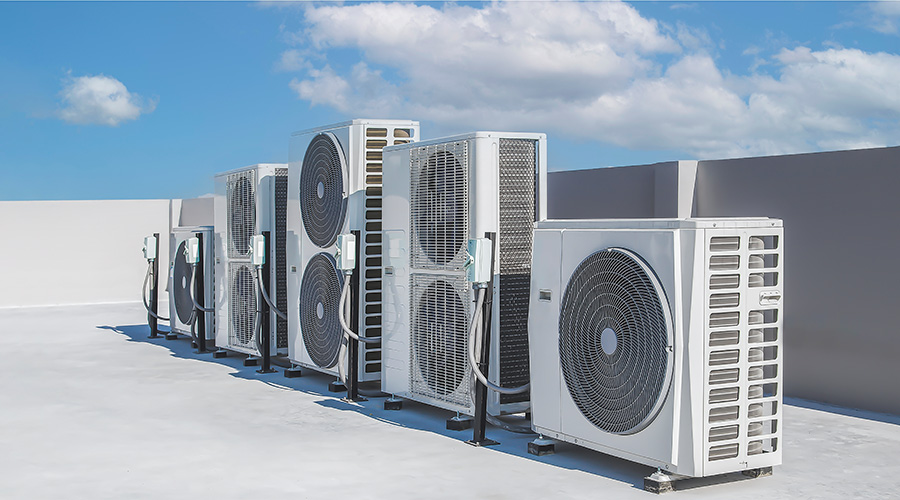What to Consider Before Using Portable Cooling
Managers must weigh factors such as square footage, load capacity when specifying units
Potential emergencies – from wildfires and floods to hurricanes and power outages – regularly threaten institutional and commercial facilities, and the threats are prompting engineering and maintenance managers to rethink their organizations’ preparedness and resilience. One critical element of preparing for and recovering from an emergency is ensuring facilities have emergency cooling for critical processes, areas and activities.
By identifying critical cooling loads in facilities, and understanding important features, functions, and requirements of portable cooling equipment, managers can help ensure success related to installing, operating and maintaining portable cooling units.
Identifying needs
All facilities operations using cooling have critical loads to some degree. Backup cooling planning is a must in all these areas, and it is vital for sensitive systems, including those in healthcare operating suites and areas with IT servers and routers. When these areas lose cooling due to deferred maintenance or equipment malfunction, issues can arise, including quality problems, loss of production, equipment damage, and health issues.
Intensive care and surgical suites in hospitals are at the top of the priority list, as are clean rooms, which have a critical need for the control of particulates, temperature, relative humidity (RH), ventilation, noise, vibration and positive pressure.
Another critical need is keeping occupants and equipment cool in hospitals, industrial plants, commercial offices and schools. Heat-generating equipment, such as IT servers, medical monitors and heat sensitive electronic control panels, need continuous cooling.
Even a small temperature difference can affect staff performance, along with equipment operation, reliability, life cycle and cost. Managers know that backup portable cooling systems can provide the needed cooling. The challenge is determining which cooling units are most appropriate for the facility’s cooling needs.
Features and functions
Small, portable cooling units include desktop coolers up to room tower coolers with an initial cost of $100-$200 and low energy costs. Among the desirable features of evaporative coolers are speed control, multi-filtration to remove large particulates and odors, handheld remote or mobile app with Wi-Fi, and off/on timers.
These units require about 10 percent of the energy needed by a large portable cooling unit, enough to spin the fan that evaporates moisture from the pad and to rotate the pad. They do not use refrigerants, which can have dangerous leaks and can increase humidity.
Selecting the most appropriate device depends on accurate hydrometer measurements. Dry air is less than 30 percent humidity, and an evaporative cooler is required. Humidity greater than 50 percent requires a portable cooling unit or fan. If the humidity varies, managers can select either evaporative cooling or portable cooling.
Other key features include capacity, oscillation control, air direction and volume, electric or electronic controls, voltage and plug arrangement, power cord size and length, dimensions, number of hoses and a water container where no drain is available.
The top performance functions to consider are the amount of cooling provided versus cooling needed and the amount of water removal. Air intake, processing, distribution and exhaust at the right cubic feet a minute (CFM) also are functions that managers also need to consider.
Portable cooling units require electrical distribution near the site where cooling is needed, as well as air intake and exhaust locations to prevent overprocessing air. A water container or a drain location near the site is required to remove condensed vapor as water.
For medium-sized spaces, managers can consider personal coolers, portable electric fans and portable cooling units. Evaporative cooler sizing uses the rule of 2: The total cubic feet of the space in question divided by 2 equals the required capacity of the cooling unit. For example, a 120-square-foot room with an 8-foot ceiling contains 960 cubic feet. When 960 is divided by 2, it equals 480 CFM, which is the cooling unit’s capacity.
Large towers and stands, fans and portable units are used for large spaces. The largest portable unit is rated at 14,000 Btu capacity. They can cool a small room of about 700 square feet, cost about $550 and feature two hoses to distribute the air. Evaporative coolers cost $500 to $1,600.
Among the specification considerations for portable air-cooled cooling unit are these:
- cooling capacity at 95 degrees, 60 percent RH – in BTU per hour
- control panel type – electronic, mechanical or programmable electronic
- air flow evaporator – high/low CFM
- air flow condenser – high/low CFM
- operating conditions – high/low temperature at 50 percent RH
- voltage/phase
- voltage – min/max
- power consumption – kilowatts
- current consumption – amps
- circuit breaker size in amps
- NEMA plug configuration
- power cord – gage and length
- dimensions – length, width and height
- weight – net and shipping in pounds
- humidity removed at 60 percent RH – gallons per hour
- drain tank – capacity in gallons
- refrigerant – type and amount
- sound level – high/low in decibels
- duct length – cold and hot.
Thomas A. Westerkamp is a maintenance and engineering management consultant and president of the work management division of Westerkamp Group LLC.
Related Topics:













